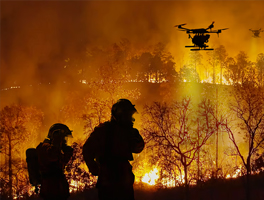 |
Dear readers,
Welcome to the Climate Weekly newsletter by the Centre for Science and Environment’s Climate Change programme and Down to Earth.
A new International Energy Agency (IEA) report, titled Global Energy Review 2025, has highlighted that extreme weather events, particularly high temperatures, were a significant factor in growing energy demand in 2024. The report states that extreme weather events drove 20 per cent of the growth in both electricity and natural gas demand, as well as contributing to a surge in coal use. In 2024, global electricity demand rose by 4.3 per cent, as opposed to 2.5 per cent in 2023. This growth was driven by a number of factors such as rising cooling demand resulting from extreme temperatures, growing industrial consumption, electrification of transport and expansion of data centres.
Further, global electricity consumption in buildings increased by 5 percent in 2024, accounting for nearly 60 per cent of the total growth in electricity consumption. The key drivers were rising demand for air conditioning—worsened by severe heat waves in countries such as China and India, as well as demand for power from new data centres. However, much of the rise in global electricity demand was met by low-emissions sources, with 80 per cent of the growth in electricity generation being provided by renewable sources and nuclear power. Together, renewables and nuclear contributed 40 per cent of the total generation, with renewables supplying 32 per cent.
Continuing with extreme weather, the Indian Meteorological Department (IMD) has shared its weather outlook for the summer season, warning that northwestern parts of India are likely to face a much hotter summer with twice the usual number of heatwave days. Typically, the region faces five to six heatwave days per season, this year however, the IMD forecast 10 to 12 heatwave days. According to the IMD, most of India is expected to experience above-normal maximum and minimum temperatures in 2025. However, it is unclear whether this summer will exceed 2024’s record breaking heat.
Lastly, according to a new study, as temperatures rise, 83 per cent of lakes globally are experiencing a decrease in surface water oxygen levels. The average deoxygenation rate in lakes has been observed to be faster than in oceans and rivers. With increasing frequency and intensity of heatwaves, the impact on lake deoxygenation may intensify—occurring more rapidly in Europe and North America compared to Africa, Asia and South America. Declining oxygen could have adverse impacts on food security and livelihoods, leading to species extinction and collapse of the commercial fishing industry.
|
|
 |
| |
 |
|
| |
 |
 |
| |
By - Upamanyu Das
Climate Change, CSE
|
| |
|
 |
|
|
| |
 |
|
| |
| EXTREME WEATHER TRACKER |
| |
Expect 'double heatwave' in northwestern states this year as IMD shares weather outlook for summer season, 27 March 2025
|
 |
 |
|
|
| |
 |
|
| |
 |
 |
‘Unprecedented’ wildfires in South Korea leave 18 dead, 19 injured as strong winds catalyse devastation, 26 March 2025
|
|
|
| |
|
|
| |
|
|
| |
 |
|
| |
|
|
| |
|
|
| |
|
|
| |
 |
|
| |
|
|
| |
 |
|
| |
|
|
| |
 |
|
| |
CLIMATE NEWS | SCIENCE| IMPACTS| POLITICS |
|
| |
 |
|
| |
|
|
| |
 |
|
| |
|
|
| |
 |
|
| |
|
|
| |
 |
|
| |
|
|
| |
 |
|
| |
|
|
| |
 |
|
| |
|
|
| |
 |
|
| |
|
|
| |
 |
|
| |
|
|
| |
| |
|
|
| Online Training Course |
| |
|
|

|
|
|
| |
|
|
|